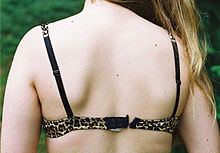eyelet
The eyelet is a ring made of metal , plastic or rubber . Garments are either a small wire or metal loop with a hook as a counterpart to hold the garments or parts of them together, or it is inserted into a hole to reinforce the edge of the hole or to protect other objects from any sharp edges of the hole.
In mountaineering and in the field of occupational safety in the field of personal protective equipment, a retaining eyelet denotes a metal ring or stable round textile belt that is attached to a harness system ( climbing harness , tether , safety harness ) and the roping , i.e. the connection of this harness system with the connecting means ( climbing rope , safety rope ) serves.
etymology
The term has been around since the 15th century AD and goes back to the word ear . Accordingly, like the word eye, it means an ear-like opening . The phrase with hooks and eyes comes from sport and means with all permitted and prohibited means .
use
Eyelets are used to reinforce holes in clothing , shoes , leather and other fabrics and to prevent the risk of tearing. They can be made of metal or plastic.
Sewn onto items of clothing or attached to jewelry and chains, eyelets with a corresponding hook on the other side serve to hold them together (cf. the eyelet fasteners on bras ).
Lacing loops are connected by lacing with a back and forth running cord. They are mainly used in shoes, but also in items of clothing such as bodices and corsets . In addition, fabrics are held together with laces , as in cover and truck tarpaulins or tent sheets .
Eyelets for reinforcing penetrations (e.g. in tarpaulins) are also known as thimbles . In seafaring, certain eyelets are generally called gatchen .
Solder lugs are used as electrical connection elements.
processing
Eyelets consist of two parts, an upper part and a lower part. The upper part is placed under the hole to be loosened and "penetrates" the material (either self-cutting or through a previously punched hole). The lower part is a flat ring over which the "nose" of the upper part is flanged using a stamp . The flanging is created by hitting the punch, by pressing with a pair of eyelet pliers or by pressing on a punch of a lever or screw press .
For better adhesion (with thin materials) and to protect the carrier material, plastic washers are used as an insert under the ring.


